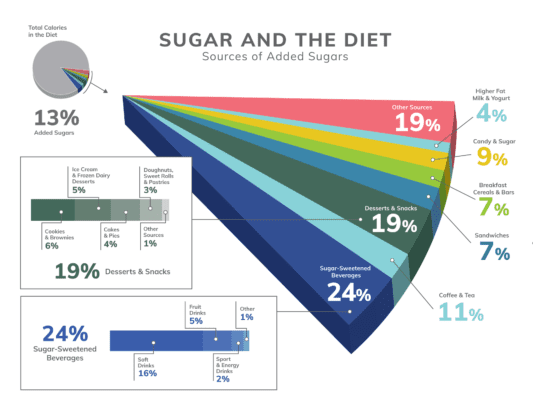WHAT ARE ADDED SUGARS?
If you hear the term added sugars but aren’t that familiar with what it means, you’re not alone. While the term has been casually used in the policy world for decades to describe sugars that are added to foods—as opposed to those found innately (i.e., sugars in an orange)— added sugars wasn’t defined by regulation until five years ago. In 2016 during the push to revise the Nutrition Facts label and include added sugars information, the FDA defined “added sugars” to include all caloric sweeteners added to foods and beverages during preparation or processing (sugar, honey and many others), as well as those packaged as such (a bag of sugar or jar of honey).
- Sugar – sucrose harvested from sugar beets and sugar cane
- Sugars – naturally occurring simple sugars (like glucose, fructose, sucrose, lactose) found in milk, fruits, and vegetables.
- Added sugars – include sugars that are added during the processing of foods (such as sucrose or dextrose), foods packaged as sweeteners (such as table sugar), sugars from syrups and honey, and sugars from concentrated fruit or vegetable juices.
- Non-caloric sweeteners – also called “high-intensity sweeteners.” These are commonly used as sugar substitutes or sugar alternatives because they are many times sweeter than sugar but contribute only a few to no calories when added to foods. These sweeteners can only be found in the ingredients list.
Starting in 2020, declaring the grams of added sugars on the Nutrition Facts Label became law, along with how that amount fits in the FDA’s daily value of 50 grams per day or 10 percent of total daily calories. The FDA stated that this information was included so that consumers could more easily follow the target of no more than 10 percent of total calories for added sugars intake recommended by the Dietary Guidelines for Americans (DGAs); allow consumers to compare products; encourage manufacturers to reformulate; and make it easier for consumers to make informed food choices as there are lot of names for added sugars and they can be hard to identify on the ingredients list.
According to consumer research conducted by the Sugar Association in March 2021, 80 percent of consumers say they read nutrition information on the front or back of packages. However, consumers are confused about how much sugar can be included in a balanced diet. According to the 2020-2025 DGAs, a healthy diet includes up to 10 percent of calories from added sugars, allowing room for sugars in nutritious foods and occasional sweets and treats.2 In a 2000 calorie diet this equates to 200 calories, 50 grams, or 12.5 teaspoons. The majority of consumers (75 percent) say it’s important to know the dietary recommendations for daily sugar intake, yet 3 in 4 consumers think the recommendation is fewer than 40 grams per day.1
More education is needed if labels are meant to help improve the dietary habits of Americans. It’s also helpful to take a step back and put added sugars into the context of the whole diet as well as take a look at which foods and beverages are contributing the most added sugars in our diets.
WHERE ARE ADDED SUGARS?
The calories contributed by all major food groups have shifted over the years. Considering the data since 1909, the contribution of calories from sugars and sweeteners reached the highest point in 1973 (18.7 percent of calories). Contribution dropped slightly from that point throughout the 1980s and climbed again, reaching another peak in the late 1990s (to 18.2 percent of calories). Added sugars intake has since been on the decline.3 As long as dietary data have been collected (over 100 years!), added sugars intake has never been below 10 percent of total calories.
Over the last 20 years, added sugars consumption has dropped nearly 30 percent, from 18.1 to 12.9 percent of total calories.4 Calorically sweetened beverages such as soft drinks, fruit drinks, coffee and tea are still the main source of added sugars in the diet across all age groups (older than 1 year), making up just over one-third (35 percent) of added sugars calories.2 While these beverages continue to be the largest contributor to added sugars intake, there has been a 33 percent drop in calorically sweetened beverage consumption since 2000.5 It is worth noting that the list of top 8 sources of added sugars also includes foods that contribute important nutrients, such as fiber, vitamins and minerals, like ready-to-eat cereals and flavored dairy.2

Data Source: Analysis of What We Eat in America, NHANES, 2013-2016, ages 1 and older, 2 days dietary intake data, weighted.
References:
- Consumer Research conducted by the Sugar Association in March 2021.
- U.S. Department of Agriculture and U.S. Department of Health and Human Services. Dietary Guidelines for Americans, 2020-2025. 9th Edition. December 2020. Available at DietaryGuidelines.gov. Accessed August 20, 2021.
- U.S. Department of Agriculture, Center for Nutrition Policy and Promotion. Nutrient Content of the U.S. Food Supply, 1909-2010. Available at: https://www.fns.usda.gov/USFoodSupply-1909-2010. Accessed November 18, 2021.
- U.S. Department of Agriculture, Agricultural Research Service. What We Eat In America, NHANES (>2 years). Available at: https://www.ars.usda.gov/northeast-area/beltsville-md-bhnrc/beltsville-human-nutrition-research-center/food-surveys-research-group/docs/wweia-data-tables/. Accessed August 20, 2021.
- Beverage Digest Fact Book, 25th Edition. Zenith International; June 2020.





Get Social with #MoreToSugar